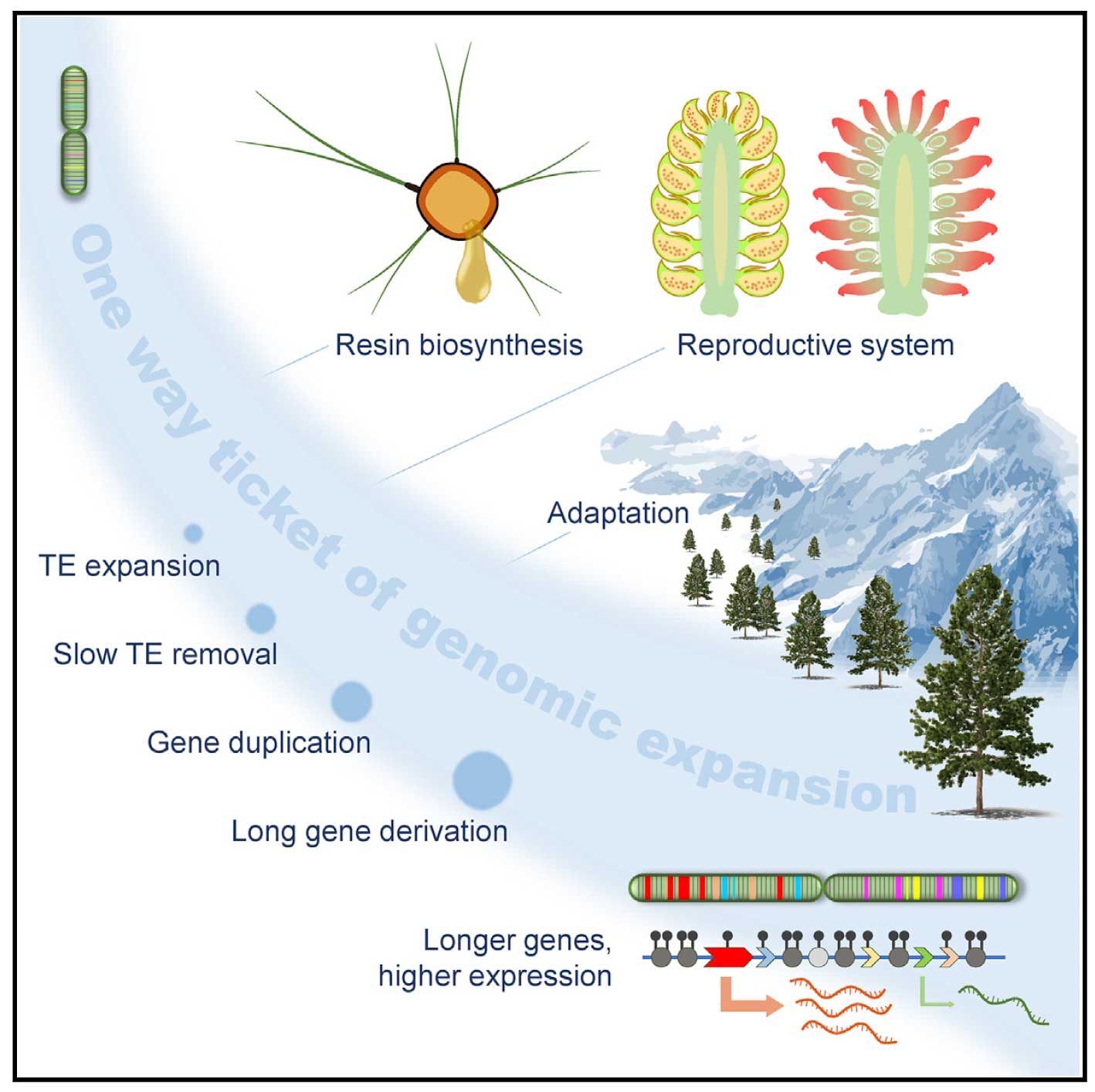博文
Cell:油松基因组揭示针叶树基因组演化的关键特征
||
The Chinese pine genome and methylome unveil key features of conifer evolution
第一作者:Shihui Niu
第一单位:北京林业大学
第一通讯:Harry X. Wu
Abstract
背景回顾:Conifers dominate the world’s forest ecosystems and are the most widely planted tree species. 提出问题:Their giant and complex genomes present great challenges for assembling a complete reference genome for evolutionary and genomic studies. 结果1-基因组大小:We present a 25.4-Gb chromosome-level assembly of Chinese pine (Pinus tabuliformis) and revealed that its genome size is mostly attributable to huge intergenic regions and long introns with high transposable element (TE) content. 结果2-基因长度与表达:Large genes with long introns exhibited higher expressions levels. 结果3-基因复制:Despite a lack of recent whole-genome duplication, 91.2% of genes were duplicated through dispersed duplication, and expanded gene families are mainly related to stress responses, which may underpin conifers’ adaptation, particularly in cold and/or arid conditions. 结果4-生殖调控:The reproductive regulation network is distinct compared with angiosperms. 结果5-TE移除:Slow removal of TEs with high-level methylation may have contributed to genomic expansion. 结论:This study provides insights into conifer evolution and resources for advancing research on conifer adaptation and development. 摘 要 
针叶树种是世界森林生态系统的主要成员,是种植范围最广的树种。针叶树种的基因组庞大而复杂,难以组装出一个完整的参考基因组,这对于基因组演化和功能研究是一个挑战。本文中,作者组装了油松(Pinus tabuliformis)25.4 Gb的染色体水平基因组组装,揭示了其基因组大小主要归因于基因间区较大、且内含子较长,含有较多的转座因子(TE)。有趣的是,内含子较长的基因反而表现出较高的表达水平。另外,尽管油松基因组上未检测到近期的全基因组复制,但91.2%的基因是通过散布复制进行复制的,并且扩张的基因家族主要与胁迫响应有关,这可能与针叶树适应其生存环境、尤其是寒冷和/或干旱条件有关。与被子植物相比,裸子植物的生殖调控网络明显存在差异。油松基因组中,具有高水平甲基化的TEs去除较为缓慢,这可能促进了针叶树种基因组的扩展。本文的研究为针叶树种的演化提供了新的视野,同时也为推进针叶树适应性和发育研究提供了基因组资源。 通讯作者 ** Harry X. Wu **
个人简介: 1993年,加拿大亚伯达大学,博士。 研究方向:对世界主要用材树种辐射松、挪威云杉、欧洲赤松开展了一系列高世代遗传育种策略的建立和全基因组选择育种研究。
doi: https://doi.org/10.1016/j.cell.2021.12.006
Journal: Cell
Published date: December 28, 2021
https://blog.sciencenet.cn/blog-3158122-1318723.html
上一篇:Science:拟南芥根组织原生韧皮部的发育轨迹
下一篇:Current Opinion in Plant Biology:植物激素控制茎尖分生组织细胞特性与生长~综述
全部作者的其他最新博文
- • Plant Physiology:CsMADS3促进柑果中的叶绿素降解和类胡萝卜素合成(华中农业大学)
- • Molecular Plant:LBD11-ROS反馈调节作用于拟南芥的维管形成层增殖和次生生长(浦项科技大学)
- • Science Advances:根结线虫通过调控植物的CLE3-CLV1模块,促进侵染进程(日本熊本大学)
- • Nature Communications:油菜素内酯参与植物营养生长期转变的分子机制解析(浙江农林大学)
- • Current Biology:光合作用产生的蔗糖驱动侧根“生物钟”(德国弗莱堡大学)
- • PNAS:花同源异型基因在叶中被抑制、花中被激活的分子机制(南卡罗来纳大学)